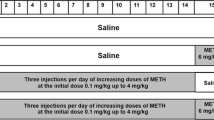Summary.
Immunoreactivities of adenylyl cyclase (AC) type I (AC-I), and basal, forskolin- and Mn2+-stimulated AC activities with or without calcium and calmodulin (Ca2+/CaM) were estimated in temporal cortex (TC)-and nucleus accumbens (NAc) membranes from brains of heroin addicts and controls. Immunoreactivity of AC-I was significantly decreased in TC from brains of heroin addicts, but that did not change in NAc. Ca2+/CaM-sensitive AC activity was significantly lower in TC from brains of heroin addicts, but that activity in NAc did not show significant difference compared with the control. Some previous reports demonstrated that Ca2+/CaM-sensitive AC activity in membranes from postmortem human brain reflected the function of AC-I. Therefore, the downregulation of AC-I in TC plays an important role in the molecular mechanism of chronic opiate addiction in human brain.
Similar content being viewed by others
Author information
Authors and Affiliations
Additional information
Received August 1, 2000; accepted August 28, 2000
Rights and permissions
About this article
Cite this article
Shichinohe, S., Ozawa, H., Hashimoto, E. et al. Changes in the cAMP-related signal transduction mechanism in postmortem human brains of heroin addicts. J Neural Transm 108, 335–347 (2001). https://doi.org/10.1007/s007020170079
Issue Date:
DOI: https://doi.org/10.1007/s007020170079




